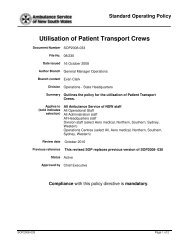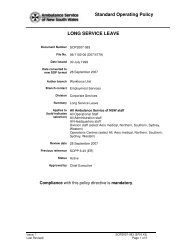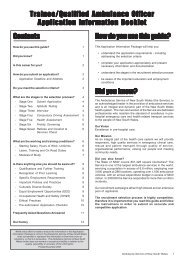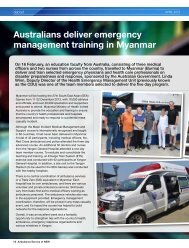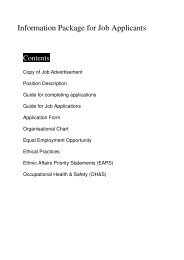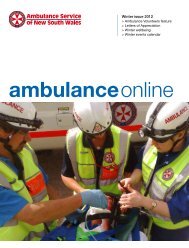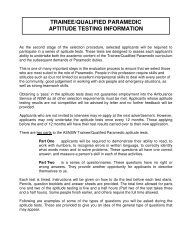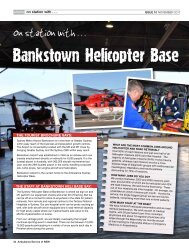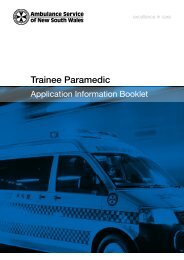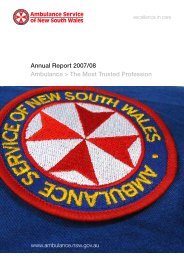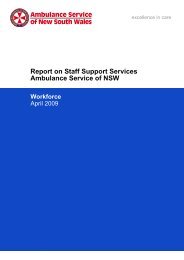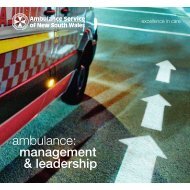atsb final report released 16 may 2013 - Ambulance Service of NSW
atsb final report released 16 may 2013 - Ambulance Service of NSW
atsb final report released 16 may 2013 - Ambulance Service of NSW
Create successful ePaper yourself
Turn your PDF publications into a flip-book with our unique Google optimized e-Paper software.
could only be achieved via the collective-mounted switches. As there was only oneswitch on each collective, the controlling pilot was unable to move bothsearchlights simultaneously. The assignment <strong>of</strong> either searchlight to themulti-position switch on the collective was achieved using a controller mounted ona panel between the two front seats. The requirement to use a separate lightingswitch to move between lights, rather than controlling both from the collective, wasnot unique to the AW139 and the ATSB is aware <strong>of</strong> other helicopter types withsimilar lighting control configurations.Due to the Nightsun/secondary searchlight switch arrangement, it was possible toinadvertently extinguish the Nightsun when assigning control <strong>of</strong> the secondarysearchlight to the multi-position switch on the collectives.In order to prevent the accidental extinguishing <strong>of</strong> the Nightsun, the master switcheson the pendant and panel-mounted controllers were required to be in the sameposition prior to selecting control <strong>of</strong> the secondary searchlight. This requirementwas included as a note in the Nightsun searchlight supplement to the AW139 RFM.An operator flying staff instruction also explained the correct use <strong>of</strong> the Nightsunmaster switches.The pilot stated that on the night, he was aware that the controller switches were notaligned and as a result there was a risk <strong>of</strong> the Nightsun being inadvertentlyextinguished. He further advised that he did not want to risk moving his (left) handfrom the collective to activate the pedestal-mounted controller while hovering inclose proximity to obstacles associated with the waterfall.The operator advised that the Nightsun and secondary searchlight providedredundant sources <strong>of</strong> illumination for pilots to ensure adequate hover referenceduring night winching. They were not intended to illuminate the winching area.Radio communication systemThe helicopter was equipped with four radios (designated COM 1 to 4) and anonboard telephone. COM 1 and COM 2 were very high frequency (VHF) radiosused by the pilot for communication with air traffic. COM 3 was a marine bandVHF radio and was the primary means <strong>of</strong> radio communication between the flightcrew and the paramedics on the ground. COM 4 was an ultra high frequency (UHF)radio that was available as an alternative means <strong>of</strong> radio communication betweenthe flight crew and personnel on the ground.The duty paramedic had portable radios that enabled him to communicate viaCOM 3 (marine band VHF) and COM 4 (UHF), and an AS<strong>NSW</strong>-issued mobiletelephone. The support paramedic had a radio that enabled him to communicate viaCOM 3, a satellite telephone and a mobile telephone. The support paramedic<strong>report</strong>ed that the satellite telephone ceased functioning during the mission due to itsbeing accidentally immersed in water.The paramedics were also able to connect a portable radio to their flight helmet;however, during operations on the ground, they used a different helmet that had noprovision to connect to this radio. The resulting need to hold the radio near theoperator’s exposed ear meant that any ambient noise, including from the helicopter,would hamper communication between the paramedics and helicopter.The air crewman (ACM) could talk on the helicopter’s internal communicationsystem (ICS) or transmit externally via the installed radios. ICS and radio- 19 -



